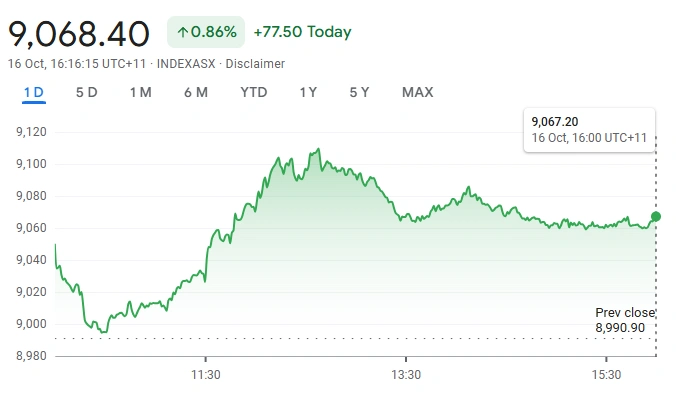The ASX 200 climbed to a fresh record high today, driven by expectations of an interest rate cut by the Reserve Bank of Australia (RBA). At 1:30pm AEDT, the index traded 81 points or 0.91% higher at 9,072 points, surging further to hit 9,109.7 later in the session. The rise follows a softer-than-expected labour force report for September, marking a shift in market sentiment.
The Australian labour market added 14,900 jobs in September, a figure below the 20,000 jobs forecast. The unemployment rate rose to 4.5%, the highest since November 2021. The report confirms a cooling in the labour market, a trend that has emerged clearly in recent months.
This cooling has renewed expectations for a possible 25 basis points rate cut by the RBA in its November meeting, with further easing anticipated in February 2026. Analysts expect the cash rate to drop to 3.35% in November and further to 3.10% in February.
 ASX 200 as of 16:00 UTC
ASX 200 as of 16:00 UTC
Sector Performances Reflect Rate Cut Anticipation
The real estate, financial, and health care sectors responded positively to renewed rate cut optimism. Interest-rate-sensitive stocks, particularly in real estate and finance, gained momentum, while health care shares continued their recovery.
The ASX overall showed strong momentum this week after a period of consolidation in September and early October. If the index maintains its break above the support zone of 9,050 to 9,025 points over the next 24 to 48 hours, analysts predict a sustained upward trend towards 9,250 points, with attention turning to 9,500 points as the year closes.
Mixed Sector Movements and Mining Sector Highlights
Among sectors, materials showed slight gains, with some explorers posting strong individual performances. Genesis Minerals rose by 5.69% to $6.87, while Bellevue Gold advanced 3.92% to $1.32. Conversely, Iluka Resources and Liontown Resources declined by 7.33% and 3.81%, respectively, at the session open.
The ASX 200 index represents about 80% of Australia’s equity market and is measured by market capitalisation of its top 200 listings. This benchmark remains critical for institutional investments in Australia.
Market Outlook and Key Influences on ASX End-Of-Year Performance
Market watchers highlight three main factors that will influence the ASX 200’s performance for the remainder of 2025: corporate earnings growth, interest rate movements, and commodity price fluctuations.
Strong earnings reports from major players such as Commonwealth Bank, Westpac, CSL Limited, and Wesfarmers will underpin market confidence. Conversely, weaker earnings could limit the potential for the index to exceed all-time highs.
The Reserve Bank’s interest rate decisions hold significant sway. The central bank has cut rates thrice in 2025, with expectations for two more cuts before year-end. Lower interest rates typically support stock valuations as borrowing costs decrease for businesses and consumers.
Commodity prices also remain a major influence. Companies like BHP Group, Newmont Corporation, and Fortescue are sensitive to fluctuations in metals such as copper and iron ore. Past spikes in these commodity prices have propelled the ASX to record highs, with any future shifts likely to impact index performance.
Also Read: Behind the Numbers: Why Australia’s Unemployment Rate Just Hit a Four-Year Peak
Additional Market Movements and Oil Prices
Energy shares had a subdued session today as oil prices eased to near five-month lows. Beach Energy and Santos experienced pressure as West Texas Intermediate crude traded at about US$58.64 per barrel and Brent crude at US$62.30 per barrel.
Meanwhile, the Australian dollar weakened sharply, reflecting renewed market caution amid the mixed economic data. Gold prices continued their strong rally, helping boost mining-related stocks.
Final Remarks
The ASX 200’s record rise today highlights its sensitivity to domestic economic data and RBA policy expectations. The labour market’s slowdown underscores the potential for imminent monetary easing, which drove real estate, financial, and health care gains. Mixed performances in mining and energy sectors reflect broader commodity trends and market uncertainty. Investor focus now turns to upcoming corporate earnings, Reserve Bank meetings, and commodity markets to guide the ASX’s trajectory toward year-end.












